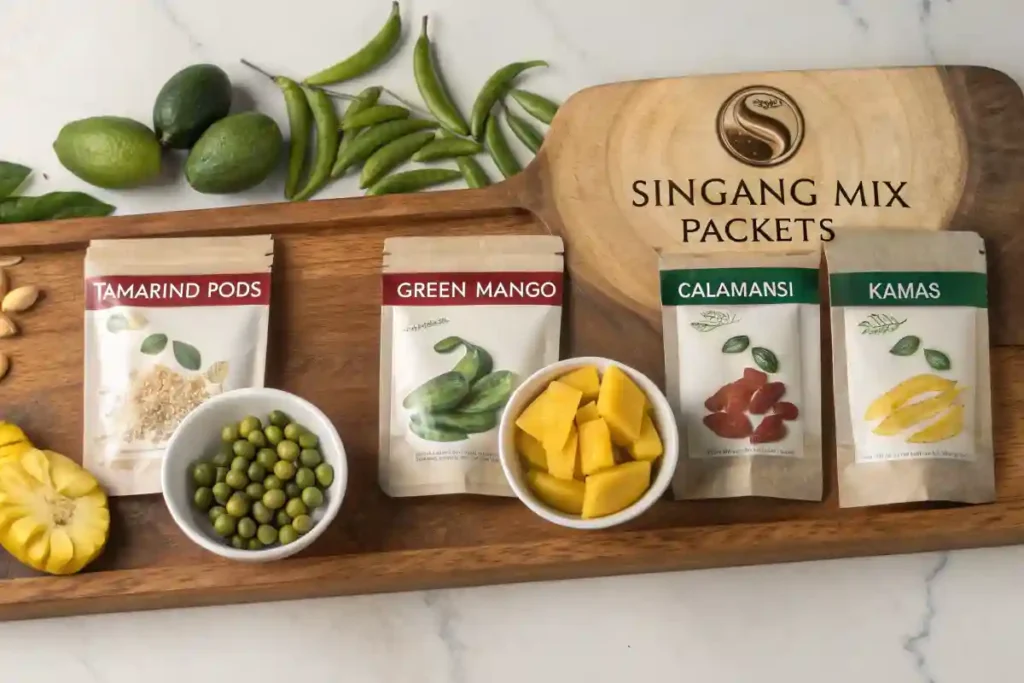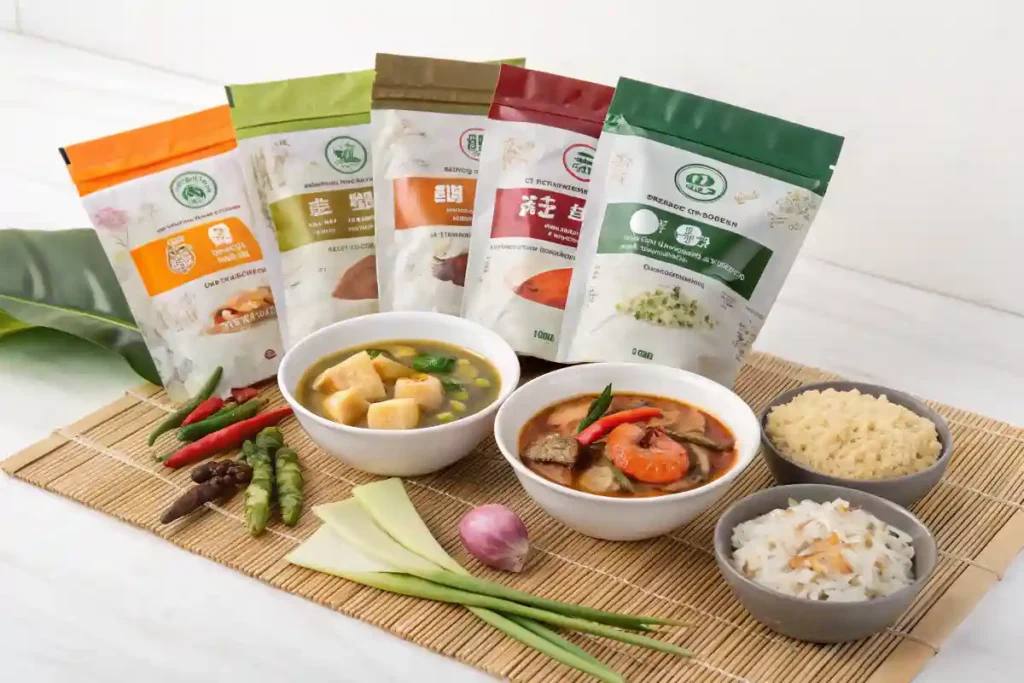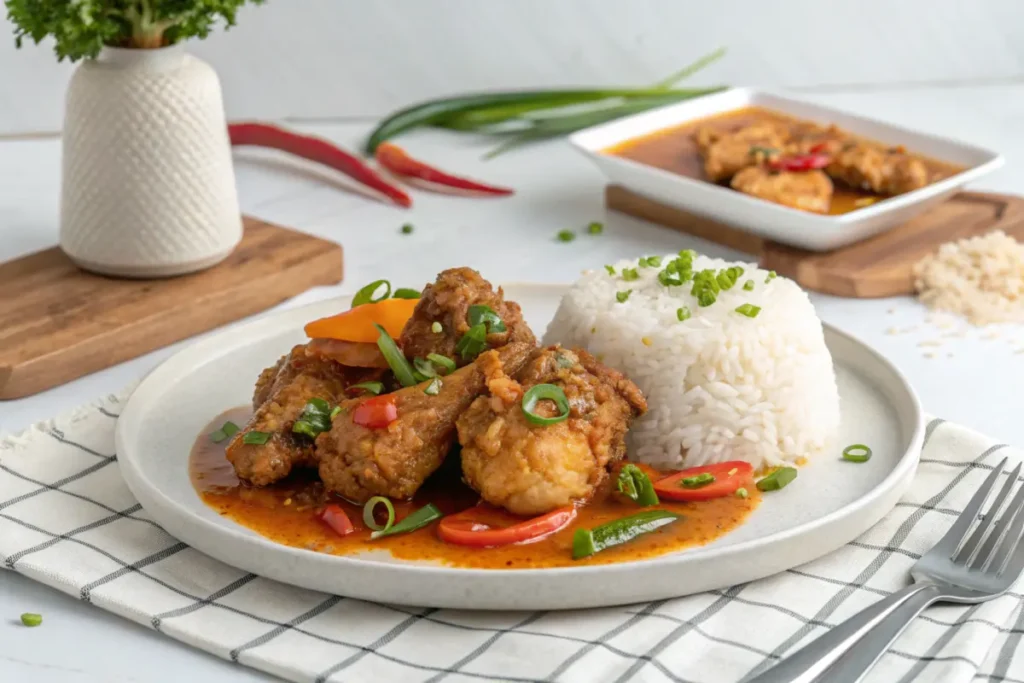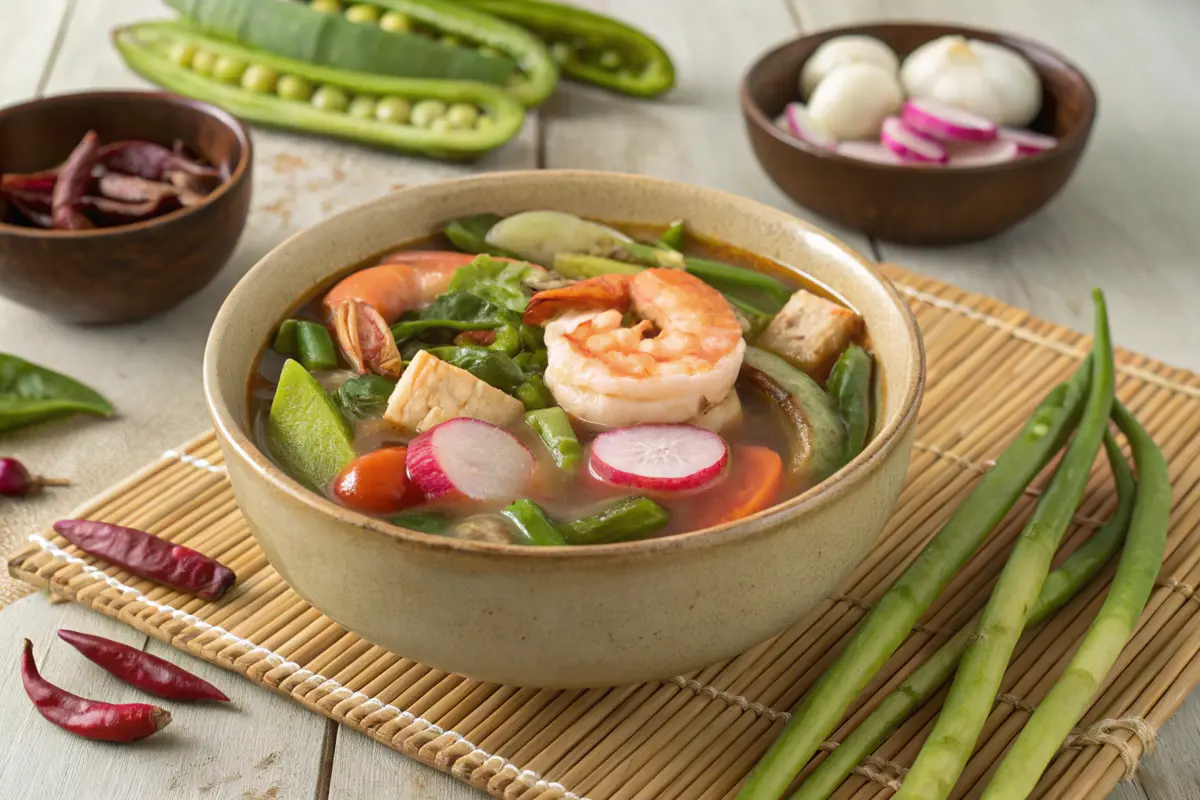inigang is a beloved Filipino dish cherished for its tangy and savory flavors, bringing comfort and warmth to countless tables. The secret to its consistent and rich flavor? Sinigang mix! In this article, we’ll uncover what makes this mix so essential, how it has evolved from traditional souring agents, and the unique types available for culinary enthusiasts. Whether you’re a first-time cook or a Sinigang aficionado, this guide has everything you need to know.
Understanding Sinigang and Its Signature Flavor
What Is Sinigang?
Sinigang is a traditional Filipino soup known for its vibrant, sour, and savory broth. It’s often made with tamarind (sampalok) as the primary souring agent, combined with an assortment of vegetables like eggplant, tomatoes, and water spinach (kangkong), and proteins such as pork, shrimp, or fish. This dish isn’t just food; it’s a culinary hug—perfect for rainy days or family gatherings.
The sourness of Sinigang makes it stand out from other Filipino dishes. It’s a flavor that embodies both comfort and nostalgia, whether you’re cooking it at home or enjoying it at a fiesta. Over the years, people have found innovative ways to recreate this tangy taste, leading to the creation of instant Sinigang mix.
Traditional Souring Agents in Sinigang

Before the convenience of packaged mixes, home cooks relied on natural ingredients to achieve that characteristic sour punch. Here’s a quick look at some popular choices:
- Tamarind (Sampalok): The most classic option, tamarind gives a fruity, slightly earthy sourness that defines traditional Sinigang.
- Green Mango: Known for its tangy yet slightly sweet flavor, green mango offers a refreshing twist to the dish.
- Calamansi: This small citrus fruit delivers a sharp, zesty sourness, perfect for light and aromatic broths.
- Kamias (Bilimbi): With its intense tartness, this fruit is a hidden gem for creating bold and flavorful Sinigang.
- Tomatoes and Guava (Bayabas): Tomatoes add a subtle tang, while guava introduces a sweet-sour flavor profile, giving Sinigang a unique twist.
These natural souring agents were the heart of Sinigang, but they often required meticulous preparation. Enter Sinigang mix—a game-changer for modern kitchens.
The Evolution of Sinigang Mix
Why Use Sinigang Mix?
In the fast-paced world we live in, Sinigang mix has become a modern kitchen staple. It eliminates the hassle of sourcing and preparing traditional souring agents, allowing even beginner cooks to enjoy authentic Filipino flavors. Convenience is a big deal—no need to boil tamarind pods or hunt for exotic ingredients like kamias!
Sinigang mix also ensures consistency in taste, which is crucial for those who want to recreate the same tangy broth every time. Plus, it’s widely available in grocery stores and online, making it easy for Filipinos abroad to whip up a comforting bowl of Sinigang that tastes like home. If you want to experiment with different twists on Sinigang, mixes with additional ingredients like gabi (taro) or spices offer exciting variations.
For more tips on mastering authentic Sinigang, visit this Sinigang recipe guide.
The Birth of Instant Sinigang Mix
Sinigang mix was introduced to bridge the gap between tradition and convenience. It all started as a powdered version of tamarind concentrate, with added spices to mimic the rich, sour flavor of the classic dish. Over the years, companies have refined these mixes, offering versions with added ingredients for texture, heat, or creaminess.
Now, Sinigang mix is more than just a shortcut; it’s a versatile seasoning for soups, stews, and even marinades. It captures the essence of Filipino cuisine while catering to the modern cook’s needs.
Types of Sinigang Mix

Original Sinigang Mix
The original Sinigang mix is the backbone of traditional recipes. Made primarily with tamarind, it delivers the familiar tangy taste that Filipinos know and love. This mix is ideal for those who want to stay true to the roots of Sinigang, combining the sourness of tamarind with subtle savory notes.
Sinigang Mix with Gabi
For a heartier twist, the Sinigang mix with gabi is a crowd favorite. Gabi, or taro, adds a creamy texture to the broth, elevating the dish to new levels of comfort food. The thicker consistency makes it a hit during colder months or for anyone craving a richer flavor.
Spicy Sinigang Mix
Feeling adventurous? The spicy Sinigang mix combines tanginess with a kick of heat. Perfect for spice lovers, this version pairs well with seafood or shrimp Sinigang, creating a vibrant and exciting bowl of soup.
Lemongrass and Other Variations
Modern iterations like Sinigang with lemongrass introduce aromatic and citrusy notes, offering a refreshing take on the dish. Some brands even experiment with rosemary or chili, catering to foodies looking to explore fusion flavors while keeping the soul of Sinigang intact.
For an in-depth look at Sinigang ingredients, you can explore this guide on Sinigang’s main components.
What Goes Into Sinigang Mix?
Ingredients Overview
So, what is Sinigang mix made of? The key ingredient is tamarind, the cornerstone of Sinigang’s sour flavor. Manufacturers often use dried tamarind powder or concentrated extract, which provides a consistent tangy base. But tamarind isn’t the only thing in these magical packets. Here’s what else you’ll commonly find:
- Salt and Seasonings: These amplify the savory undertones of the dish, balancing out the tanginess.
- Flavor Enhancers: Ingredients like monosodium glutamate (MSG) or natural umami sources elevate the broth’s depth.
- Acidity Regulators: These ensure the sourness remains fresh and vibrant over time.
- Herbs and Spices: Depending on the mix, you might find dried garlic, onion powder, or chili flakes for added complexity.
While the specific formula varies by brand, the result is always the same: a reliably tangy, mouthwatering broth that tastes just like home.
For more ideas on creating comforting soups, consider exploring this Sinigang recipe guide.
Manufacturing Process
Turning tamarind and seasonings into that handy powder or paste involves a meticulous process. The tamarind is dried and pulverized, then mixed with other ingredients to create a uniform blend. Quality control ensures every packet delivers the same level of sourness and consistency. Some mixes also incorporate dried vegetables or additional thickening agents like starch to enhance the final dish.
Nutritional Aspects
While Sinigang mix is a fantastic kitchen shortcut, it’s worth noting the nutritional content. Most mixes are low in calories but can be high in sodium. If you’re watching your salt intake, you might want to use the mix sparingly or balance it with fresh ingredients. Some brands also offer low-sodium or MSG-free versions to cater to diverse dietary needs.
How to Use Sinigang Mix
Basic Steps for Cooking Sinigang
Making Sinigang with the mix is almost foolproof! Here’s how you can recreate the perfect bowl:
- Choose Your Protein: Pork belly, shrimp, or even milkfish (bangus) are popular options.
- Prepare Vegetables: Slice radish, eggplant, and tomatoes; rinse leafy greens like kangkong.
- Sauté Aromatics: Begin by sautéing onions, garlic, and tomatoes to build a flavorful base.
- Add Water and Protein: Simmer your chosen protein in water until tender.
- Incorporate Sinigang Mix: Stir in the mix, letting it dissolve fully for that signature tangy taste.
- Add Vegetables: Toss in veggies based on their cooking time, with leafy greens going in last.
Serve it piping hot alongside steamed rice, and you’ve got a meal that hits the spot every time.
Creative Dishes Using Sinigang Mix

The versatility of Sinigang mix goes beyond soup. It can enhance various recipes with its distinctive sour flavor:
- Sinigang Fried Chicken: Marinate chicken in the mix for a tangy twist before frying.
- Sinigang-Flavored Ramen: Combine the mix with broth and noodles for a Filipino-Japanese fusion.
- Sinigang-Glazed Veggies: Stir-fry your favorite vegetables and finish them with a Sinigang glaze for a zesty kick.
For more creative ways to use Sinigang mix, check out related articles on recipefoodies.com.
FAQs About Sinigang Mix
Can I Use Sinigang Mix with Different Proteins?
Absolutely! One of the greatest things about Sinigang mix is its versatility. While pork is the traditional choice, you can also use shrimp, chicken, beef, or fish. Each protein brings its unique flavor to the dish, enhancing the tangy broth in delightful ways. For a lighter twist, try using milkfish (bangus) or prawns—they pair exceptionally well with the sour notes of the mix.
Is Sinigang Mix Gluten-Free?
This depends on the brand, so always check the label if you have dietary restrictions. Many mixes are naturally gluten-free, focusing on tamarind and seasonings. However, some versions may include additives that contain gluten. If in doubt, opt for a certified gluten-free product to ensure it aligns with your dietary needs.
What Are Alternatives for Vegetarians?
Vegetarians can still enjoy the tangy goodness of Sinigang! The mix itself doesn’t contain animal products, so it’s easy to use with plant-based proteins like tofu or tempeh. You can also load the soup with vegetables such as radish, okra, and leafy greens for a hearty, meat-free option.
Can I Store Sinigang Mix Long-Term?
Yes, Sinigang mix is shelf-stable and can last for months when stored properly. Keep it in a cool, dry place, away from sunlight and moisture. Once opened, transfer the remaining contents into an airtight container to maintain freshness.
Conclusion and Final Thoughts
Sinigang mix has become a household staple for good reason. It takes the guesswork out of preparing this beloved Filipino dish, offering consistent flavor in a convenient package. Whether you’re new to Filipino cooking or a seasoned pro, Sinigang mix makes it easy to recreate that signature tangy broth with minimal effort.
From its tamarind-based origins to its creative modern variations, Sinigang mix is a testament to how tradition and innovation can blend seamlessly. Plus, its versatility extends beyond soup—you can use it to marinate, glaze, or even spice up your stir-fry!
So, what is Sinigang mix made of? It’s a carefully balanced combination of tamarind, seasonings, and sometimes a little something extra, all designed to bring out the best in your cooking. Give it a try and experience the comforting flavors of Sinigang, whether it’s a rainy day, a family gathering, or just a quiet evening at home.
For more inspiration and recipe ideas, explore related articles on recipefoodies.com.
Healthier and Alternative Options for Sinigang Mix
Are There Healthier Variants of Sinigang Mix?
Yes! With increasing awareness of dietary preferences, many brands now offer healthier options for Sinigang mix. These versions may include:
- Low-Sodium Mixes: Perfect for those watching their salt intake while still enjoying the tangy goodness of Sinigang.
- MSG-Free Mixes: If you prefer to avoid flavor enhancers, look for mixes that highlight natural ingredients like dried tamarind and spices.
- Organic and All-Natural Mixes: These cater to those who prioritize clean labels and minimally processed products.
While the flavor might slightly differ, these options are a great way to balance convenience with health-conscious choices.
Can You Make Sinigang Without Store-Bought Mix?
Absolutely! While convenient, Sinigang mix isn’t the only way to recreate this dish. Traditional souring agents like fresh tamarind, green mango, or calamansi can be used. For an authentic touch, boil tamarind pods, mash the pulp, and strain it into the broth. The process might take a little extra time, but the flavor is deeply rewarding.
If you’re curious about other Filipino cooking tips, consider visiting recipefoodies.com for inspiration.
Why Sinigang Mix Stands Out in Filipino Cuisine
Convenience Meets Tradition
One of the standout features of Sinigang mix is how it bridges traditional cooking methods with modern convenience. In Filipino households, Sinigang is more than just a dish; it’s a cultural treasure. The mix honors this legacy by making it easier to prepare Sinigang without compromising its authentic taste.
Even for those living abroad, Sinigang mix provides a comforting connection to home. Its tamarind base evokes memories of shared meals, rainy days, and family gatherings.
Versatility Beyond Sinigang
Another reason Sinigang mix is so special is its versatility. While primarily used for soups, it has found its way into creative recipes. From marinated meats to tangy stir-fries, the mix proves it can do much more than create a single dish. It’s a culinary shortcut that doesn’t limit creativity—it inspires it.
So, what is Sinigang mix made of? It’s more than just a blend of tamarind and spices—it’s a symbol of tradition, innovation, and adaptability.

